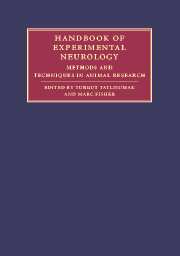Book contents
- Frontmatter
- Contents
- List of contributors
- Part I Principles and general methods
- 1 Introduction: Animal modeling – a precious tool for developing remedies to neurological diseases
- 2 Ethical issues, welfare laws, and regulations
- 3 Housing, feeding, and maintenance of rodents
- 4 Identification of individual animals
- 5 Analgesia, anesthesia, and postoperative care in laboratory animals
- 6 Euthanasia in small animals
- 7 Various surgical procedures in rodents
- 8 Genetically engineered animals
- 9 Imaging in experimental neurology
- 10 Safety in animal facilities
- 11 Behavioral testing in small-animal models: ischemic stroke
- 12 Methods for analyzing brain tissue
- 13 Targeting molecular constructs of cellular function and injury through in vitro and in vivo experimental models
- 14 Neuroimmunology and immune-related neuropathologies
- 15 Animal models of sex differences in non-reproductive brain functions
- 16 The ependymal route for central nervous system gene therapy
- 17 Neural transplantation
- Part II Experimental models of major neurological diseases
- Index
- References
15 - Animal models of sex differences in non-reproductive brain functions
Published online by Cambridge University Press: 04 November 2009
- Frontmatter
- Contents
- List of contributors
- Part I Principles and general methods
- 1 Introduction: Animal modeling – a precious tool for developing remedies to neurological diseases
- 2 Ethical issues, welfare laws, and regulations
- 3 Housing, feeding, and maintenance of rodents
- 4 Identification of individual animals
- 5 Analgesia, anesthesia, and postoperative care in laboratory animals
- 6 Euthanasia in small animals
- 7 Various surgical procedures in rodents
- 8 Genetically engineered animals
- 9 Imaging in experimental neurology
- 10 Safety in animal facilities
- 11 Behavioral testing in small-animal models: ischemic stroke
- 12 Methods for analyzing brain tissue
- 13 Targeting molecular constructs of cellular function and injury through in vitro and in vivo experimental models
- 14 Neuroimmunology and immune-related neuropathologies
- 15 Animal models of sex differences in non-reproductive brain functions
- 16 The ependymal route for central nervous system gene therapy
- 17 Neural transplantation
- Part II Experimental models of major neurological diseases
- Index
- References
Summary
Overview
A neuroscientist embarking on a study of reproduction is eminently aware that an animal model chosen must consider gender differences and the endocrine factors determining them. Neuroscientists embarking on a study of function unrelated to reproduction may require the same consideration. It is now clear that gonadal hormones are important contributors to sex differences in a wide array of non-reproductive brain activities.
This conclusion has emerged from studies with animal models, sometimes unexpectedly when the experimental paradigm has included both males and females as subjects. Other findings of sex differences were observed first in human populations that suggested further study with animal models.
This review is a sampling of the remarkable variety of sex differences uncovered in adult brain function of which a neuroscientist may be unaware. A recent personal experience serves as an example. A respected colleague mentioned a new project to be conducted in her laboratory using an animal model of neuropathic pain. The interest was on a hypothesized acute attenuation of pain from treatments with a glutamate antagonist. Because the animal colony had an abundance of female rats, the subjects were to be groups of females. The assumption was that the topic had little relevance to reproduction and reproductive hormones, and any findings could be generalized equally to both sexes. Yet, there are reasons to question both assumptions. Both pain and glutamatergic pathways are influenced by sex hormones, and males and females may respond quite differently.
- Type
- Chapter
- Information
- Handbook of Experimental NeurologyMethods and Techniques in Animal Research, pp. 239 - 256Publisher: Cambridge University PressPrint publication year: 2006
References
- 1
- Cited by



